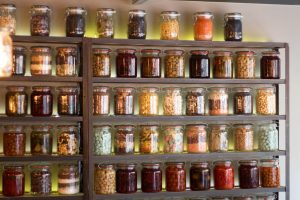
Now that we live off-grid lacto-fermentation is a way that I can store a little produce without taking up precious cooler space. That cooler is usually full of dairy products and nothing lasts long in there anyways.
In the summer when produce is rolling in at markets, from your garden, or in this case from neighbors I like to ferment little things here and there. Salsa, pickles, peppers, and now this summer squash.
You can use zucchini or yellow crookneck or pattypan if you want. You can also use whatever seasonings you have on hand or any herbs ready to harvest in the herb garden. In this jar the only thing that didn’t come from my garden or a neighbor’s was the salt and water, the latter of which is filtered rain water.
Close to home, good for your gut, and a good way to store food without refrigeration. It doesn’t get much better than that.
Lacto-Fermented Summer Squash
Source: plantoeat.com
Course: Fermented Fruits and Veg
Main Ingredient: Vegetables
Serves:
Ingredients
- 1-2 medium sized summer squash cut into 1/2″ chunks just enough to fit in a quart jar
- peppers onions, or garlic to season
- a few sprigs of parsley cilantro, dill, oregano, or any other herb you have
- a couple of mesquite oak, or grape leaves to keep them crunchy
- 1 quart filtered water
- 2 tablespoons sea salt
Directions
- Combine water and sea salt, stir well and set aside.
- Add a few pinches of herbs and the peppers/onions/garlic of your choice to the bottom of a quart jar. Fill jar halfway up with chunks of summer squash. Add a bit more herbs and seasonings and fill the jar with squash chunks up to 1-2″ below rim.
- Pour salt water brine over the squash. At this point you want to weigh the squash down in order for it to remain below the level of the brine and ferment evenly. This isn’t an ideal solution, but I like to use a narrow-mouthed lid in my wide-mouth quart ferments. Just press it down until enough brine covers it that it weighs the squash down.
- Cover tightly with a canning lid and ring. Allow to sit out at somewhere near room temperature, ideally 60-80 degrees. Check your jars and burp them every 12 hours or so by loosening the lid and allowing some gas to escape.
- Let ferment 2-5 days, depending on temperature and then transfer to cold storage (refrigerator, root cellar, etc.).






